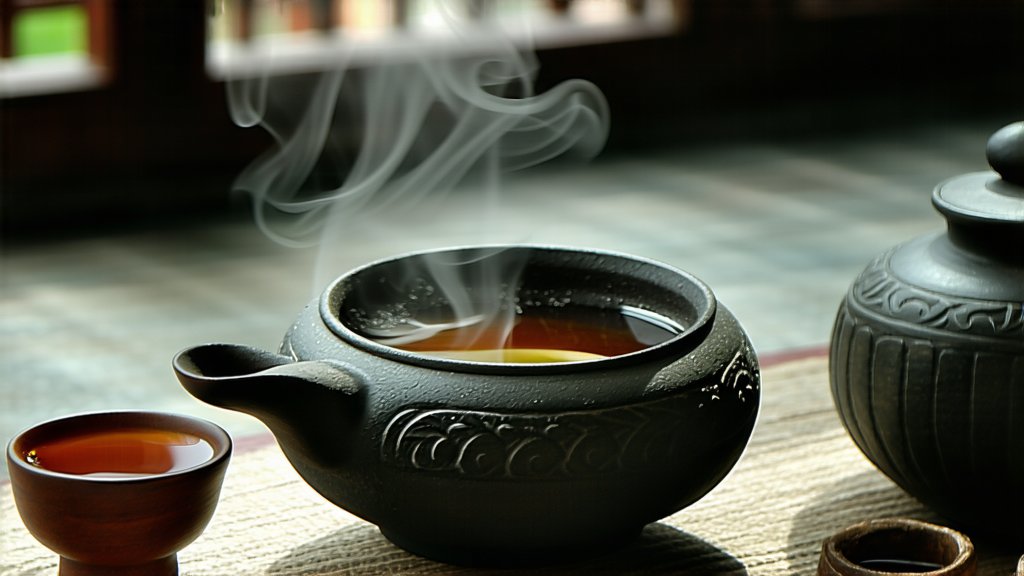
Pu-erh tea, often referred to as the "living tea," stands as one of the most unique and fascinating categories within the vast spectrum of Chinese tea culture. Originating from the Yunnan Province in southwestern China, this dark tea has a history that spans over a millennium, with its roots deeply intertwined with the ancient trade routes and cultural exchanges along the Silk Road. Unlike other teas that are generally consumed fresh, Pu-erh undergoes a fermentation process that continues to mature and improve its flavor profile over time, making it a subject of great intrigue for both novices and connoisseurs alike.
Historical Significance and Cultural Context
The story of Pu-erh tea begins during the Tang Dynasty (618-907 AD), but it wasn't until the Ming Dynasty (1368-1644 AD) that its production became more organized. Its name is derived from the market town of Pu'er in Yunnan, where tea merchants would gather to trade their goods. The tea gained prominence not just domestically but also internationally, becoming a highly sought-after commodity along the ancient Tea Horse Road, a network of trails that connected Yunnan to Tibet and further to Southeast Asia. This route facilitated not only the trade of tea but also cultural and religious exchanges, solidifying Pu-erh's status as more than just a beverage; it became a symbol of diplomacy and friendship.
Varieties and Classifications
Pu-erh tea is broadly categorized into two main types: Raw Pu-erh (Sheng Cha) and Ripe Pu-erh (Shou Cha). Raw Pu-erh undergoes natural fermentation through aging, allowing its flavors to evolve gradually over years or even decades. This type is prized for its complex taste and potential for transformation. On the other hand, Ripe Pu-erh is accelerated through a post-fermentation process known as 'wo dui,' which mimics the aging process and results in a mellower, earthier flavor profile that can be enjoyed relatively soon after production.
Furthermore, Pu-erh can be found in various forms, including loose leaves, bricks, cakes (or 'bing'), and tuocha (smaller compressed shapes). Each form serves practical purposes related to storage, transportation, and portion control but also adds to the ritualistic aspect of tea preparation and enjoyment.
The Art of Crafting Pu-erh
The production of Pu-erh tea involves several intricate steps, starting with the careful selection of sun-dried Camellia sinensis leaves, primarily from ancient tea trees known as 'gushu.' These leaves are then withered, rolled, and sun-dried again before being sorted and graded based on size and quality. For Raw Pu-erh, the leaves are compressed into their respective forms without further processing, leaving them to age naturally. In contrast, Ripe Pu-erh undergoes a 'wet piling' process where piles of tea are kept moist and warm to encourage microbial activity, accelerating the fermentation process. This controlled environment fosters the growth of beneficial fungi and bacteria that contribute to the tea's distinctive characteristics.
Appreciating the Essence of Pu-erh: The Art of Tasting
To truly appreciate Pu-erh tea, one must engage in a mindful tasting ritual that goes beyond mere consumption. The experience begins with the visual inspection of the dry leaves, noting their color, shape, and any visible signs of aging. Next comes the aromatic exploration, where the dry leaves are warmed in a gaiwan (a traditional Chinese teapot) to release their scent, followed by a sniff of the brewed tea to detect subtle changes in fragrance.
When it comes to brewing, water temperature and steeping time play crucial roles. Typically, Raw Pu-erh requires higher temperatures (around 200°F or 93°C) and shorter steeps initially, gradually increasing as the leaves open up. Ripe Pu-erh, due to its already softened nature, can tolerate slightly cooler water (around 195°F or 90°C) and longer infusion times. The first few infusions serve to 'wake up' the leaves, with subsequent brews revealing deeper layers of flavor and complexity.
Tasting Pu-erh involves savoring its multifaceted profile, which includes sweetness, bitterness, astringency, and umami notes. A well-aged Raw Pu-erh may exhibit fruity, floral, or woody undertones, while Ripe Pu-erh often showcases earthy, mushroom-like qualities. Aftertaste and mouthfeel are equally important indicators of a high-quality Pu-erh, with the best examples leaving a lasting, pleasant sensation on the palate.
Health Benefits and Modern Appeal
Beyond its cultural significance and sensory delights, Pu-erh tea has garnered attention for its potential health benefits. Studies suggest that regular consumption may aid in weight management, improve digestion, lower cholesterol levels, and support cardiovascular health. The tea's rich content of polyphenols, particularly catechins and theaflavins, acts as antioxidants that help combat free radicals in the body. Additionally, the microbial fermentation process in Ripe Pu-erh produces unique compounds like loquat saponin B and C, which have been linked to anti-inflammatory properties.
In recent years, there has been a resurgence of interest in Pu-erh worldwide, fueled by a growing appreciation for traditional practices, sustainable agriculture, and the quest for healthier lifestyle choices. Enthusiasts gather at tea ceremonies, attend specialized tea houses, and participate in online forums to share their experiences and knowledge, fostering a global community united by their passion for this ancient yet ever-evolving beverage.
In conclusion, Pu-erh tea embodies the essence of Chinese tea culture – a harmonious blend of history, artistry, and wellness. Its journey from leaf to cup is a testament to human ingenuity and respect for nature's cycles. As we continue to unravel the mysteries of this 'living tea,' we not only celebrate its past but also pave the way for future generations to discover and cherish its timeless allure.